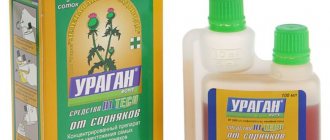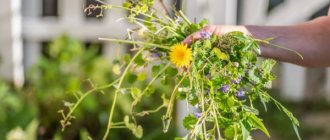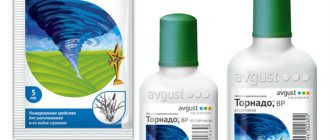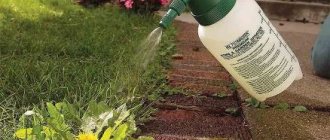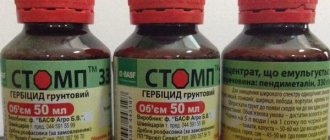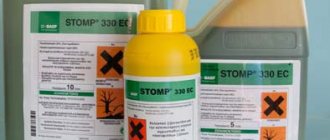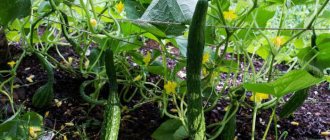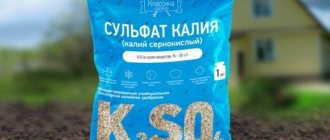Category: Pesticides Reading time: 9 min · Views: 1,520
Who among gardeners and gardeners has not had to pick it out of the soil, cursing and remembering the ancestors of this plant? 50 centimeters, 80, a meter, two, another piece... now the root has become thinner and rrrr! - he broke off. And about a week later, sharp, long, bright green leaves brazenly emerged from the place where that root was broken. Cheers! It's me - wheatgrass! About 40 years ago, the non-selective herbicide Roundup was introduced to help control weeds.
Roundup herbicide comes to the rescue
More recently, the epithet “invincible” was applied to wheatgrass, thistle or horse sorrel. Indeed, the root system is amazing: in “repeat offender” plants that stuck in one place for several years, the main root could reach a length of 15 meters! At the same time, even a piece of 5-10 cm left in the ground after careful (seemingly) care can soon give rise to a full-fledged plant, which will grow again (and mostly underground!) at a speed of up to 5 centimeters per day.
The Roundup formula is not based on copying the structure of natural toxins; it is designed in its pure form by chemists. Therefore, its effect is indiscriminate; if it gets on cultivated plants, it will destroy them too. Therefore, it is so important, firstly, to use serviceable equipment when processing areas (the use of sprayers not adjusted to a fine spray stream is not allowed) and, secondly, to strictly follow the instructions for use.
Dosage of the drug
Depending on the type of weed, the length of their roots and degree of vitality, the amount of product per 10 liters of water may require from 40 to 120 milliliters. For perennials, the concentration is usually maximum. The dilution table for Roundup in water is given on the packaging of the product, so you can make a mistake unless you have at least minimal knowledge of agronomy. But what gardener or gardener does not have such knowledge? In practice, using the tool might look like this:
- When treating annual weeds, Roundup is diluted in 10 liters of water in an amount of 60 ml.
- If perennial weeds have settled on the site, the dosage will be about 120 ml per 10-liter container.
- In areas with melons or potatoes, an area of 200 sq. m. use a solution of 80 ml per 10 liters of water.
- In vineyards and garden plots with fruit bushes, Roundup is also diluted in a ratio of 80 ml per 10 liters of water.
- After harvesting, preventive treatment of garden areas is usually carried out. To do this, the drug is also diluted at the rate of 80 ml per 10 liters of water (an area of 200 square meters).
During harvesting and immediately before harvesting, Roundup should not be used under any circumstances!
Action of Roundup
This herbicide, bearing in mind its generally non-selective effect on any plants, is especially useful for use in virgin areas where wild plants such as burdock, burdock, thistle, horse sorrel, sow thistle and wheatgrass have long and firmly established themselves. To free up the land, total processing of everything growing on the site is carried out.
The effect of the drug begins immediately. Once on the leaves and stems of plants, it is absorbed into them and begins to move deeper into the plant, reaching the thinnest roots. Roundup works by blocking metabolic processes in plant cells at the molecular level, which causes their death.
The active ingredient is isopropylamine salt of glyphosate mixed with a surfactant (surfactant) polyoxyethyleneamine, added to reliably fix the main substance on plant parts.
One of the main conditions during application is the use of Roundup in dry weather.
Description of the drug
Systemic herbicide Roundup is a universal, continuous action product for the destruction of weeds. After a single application, you can count on complete cleansing of the land from all types of weeds. To do this, you must use the drug correctly, in full accordance with the instructions.
The manufacturer of this product is the transnational corporation Monsanto. The drug is a slightly viscous liquid with a slight odor.
In our country you can find it on sale in several dosages:
- Roundup - the formula of this drug contains 360 g/l of active ingredient.
- Roundup Max - 450 g/l.
- Roundup Extra - 540 g/l.
For ease of use, the drug is packaged in different quantities:
- For use in small garden areas there are convenient 5 ml ampoules, 50 ml and 100 ml bottles.
- A 1 liter bottle is enough to clear weeds from the territory of a private farm.
- To treat large areas and agricultural land, it is more convenient to purchase Roundup in 20-liter canisters.
Composition and active substance
Roundup contains:
- Glyphosate (active substance).
- Surfactant (a means for increasing the stickiness of the drug to the surface of plants).
The substance glyphosate (isopropylamine salt) is a non-selective systemic herbicide. It kills absolutely any plant without showing any selectivity. The exception is genetically modified crops. In terms of production volumes and use in agriculture, this drug is in first place among herbicides in all countries of the world.
Mechanism of action
- Once on the green surface of the leaves and stems of a plant , Roundup lingers on it with the help of an additive - an adhesive.
- The active substance, glyphosate, gradually penetrates the weed cells. It interferes with metabolism and blocks the synthesis of several vital compounds, resulting in the death of the plant.
- It takes approximately 6 hours for the substance to be absorbed and penetrate the weed. The herbicide then slowly spreads throughout all parts of the plant, including the root system. This takes about a week.
- From this moment (6 - 7 days) you can observe external signs of the drug’s effect : weeds begin to turn yellow and wither.
When is herbicide used?
You can treat the area with Roundup and begin weed control throughout the entire growing season: spring, summer or fall.
This product does not have soil activity, that is, it can only affect the green parts of plants. To get the best result, you need to choose the right moment for processing. It all depends on the individual situation and task.
What is useful to know when using Roundup
If you come up with the idea of not using the land for garden crops on your garden plot, but rather sowing a lawn, treat the entire land with Roundup, down to the last square centimeter. It is better to do this in early spring, after the snow has melted, when more or less warm, stable weather has established with an average daily temperature above zero degrees Celsius. After this, you need to wait at least two weeks, loosen the soil, and then you can add lawn seeds. In two weeks, the remaining herbicide will decompose in the soil.
Any weeds not only take away nutrients from cultivated plants, but also spoil the aesthetic appearance of the plots, especially if a designer took part in the design. This applies most of all to places near buildings or fences, where decorative hedges and protective green walls are planted. There, Roundup treatment is carried out selectively, and preferably during the summer months.
If the site is overpopulated by weeds of various types - simultaneously with annual and perennial plants, with a massive above-ground part (burdock, thistle) and with an extended or branched root system (wheatgrass, horse sorrel), herbicide treatment will not be enough to ensure that later planted cultivated plants felt comfortable. Especially if the owner of the site has declared war on the dangerous hogweed (or bunch, as it is called in the eastern regions of our country).
Therefore, after treatment, the area should rest and remain empty until the next season. In autumn, winter and spring, the remnants of the drug will completely decompose in the soil and it will become safe for growing food.
Reviews from gardeners and gardeners
I used Roundup on a virgin plot. The drug helped destroy all the weeds and after digging I use it to grow vegetables. Weeds appear in the new area, but little by little, I won’t say abundantly
Natalia Gvozdyuk
Kasimov
I have a negative experience using this drug. She sprinkled it on the lawn, but was in a hurry to sow the grass. Nothing grew. The lawn turned out only the next year after the new sowing.
Ksenia Ivanova
Moscow region
I tried to spray the area behind the fence with Roundup and was convinced that it was better not to use it in the garden. For three years now there hasn’t been a single blade of grass near the fence. I can imagine what would happen if I treated the garden. So I advise everyone to be careful with chemicals in their gardens.
Fedor Konyukhov
Vladimir region
I came across negative reviews online about herbicides like Tornado, Roundup and others. Think. That they are all from people who sprayed the area incorrectly. I personally rid the virgin plot of malicious weeds and now I am growing a vegetable garden on it. I sprayed the area “killed” by the weed, and the grass dried up after 2 weeks. And a month later it grew again. So all the tales about poisoned soil are complete nonsense.
Matvey Solovchuk
Samara
Use Roundup, without it it will be very difficult to develop virgin soil. My husband and I bought a dacha that was completely overgrown with weeds almost as tall as a man. They hired Tajiks who dug up the ground twice - all in vain! The shoots still grew, especially nettles. Only Roundup helped get rid of this nightmare. Now the former grass forest has been turned into a lawn and flower beds, to the envy of all the neighbors. So, use herbicides and do not be afraid to harm crop plants.
Maria Kuznetsova
Moscow
I don’t know what concentration the solution needs to be made in order to rid the area of the weed at one time, as it says on the package. Next to my dacha there is an abandoned plot and grass is growing out of it. I sprayed it with Roundup, and after a week the weeds began to dry out. But not even 10 days had passed, everything was again covered with wheatgrass, sow thistle and nettles.
Olesya Karavaeva
Ryazan
Environmental Safety
Over almost half a century of using Roundup in the fight against weeds, the initially enthusiastic attitude towards it among gardeners and agricultural technicians gradually gave way to caution in its use. The fact is that data on the carcinogenic properties of this drug have begun to accumulate, and this effect is instantaneous. What does this mean in practice? All glyphosates upon contact with the skin immediately disrupt the genome of epithelial cells, and this can already be qualified as a precancerous condition.
In the long term, if it enters the human body, the offspring may also develop signs of autism. In addition, the uncontrolled use of Roundup from year to year contributes to the emergence of superweeds, or mutant weeds that are completely insensitive to the action of the herbicide.
Then, an important factor in the prohibition of use was the fact that the harmful effect of the active substance - glyphosate, is cumulative, that is, accumulative, systemic and global in nature. The situation that happened at one time with DDT was repeated, particles of which were found even in Antarctic ice.
Unused glyphosates, in case of violation of the technology of application to the soil (for example, in case of an overdose of the product), it turns out, in the process of destroying the weed, bind ions of any metals located there in the soil. And this is already a gene poison in its consequences.
That is why manufacturers so insist on unconditional compliance with all provisions of the instructions for the drug, urge not to use it “by eye” and to observe the temperature regimes for processing plants.
Meanwhile, the Agricultural Commission of the European Parliament has already called for Roundup to be withdrawn from mass use within the next five years.
Characteristic
Often, gardeners try to get rid of weeds manually or resort to a mechanical option. However, they will not always allow you to get rid of parasites that take away the nutrition of your plants with 100% certainty by depleting the soil of mineral fertilizers.
In this case, the drug “Ground” VR is the means of last resort. "Ground" is a continuous action herbicide, i.e. it is able to affect all weeds and crops equally, and not chaotically.
Spectrum of action
The drug has a fairly wide spectrum of action, and among its purposes it is necessary to highlight the following:
- destruction of weeds of various types and varieties - sow thistle, wheatgrass, which enter the active growth phase as soon as the gardener needs to plant grain and tuber crops, root crops. Treatment is necessary precisely in order to maximally clear the soil of weeds and plant the plant in normal, treated and safe soil. — processing of fields before the gardener and agricultural worker plants spring and winter crops. Thus, the product is suitable not only for local treatments, but also for treating larger areas. — treatment of embankments of automobile and railway tracks, which is also extremely necessary, because weeds grow there, which can significantly disrupt the structure of the coating and generally spoil the appearance. In addition, Ground is excellent for processing power lines, for beautifying parks and recreation areas, alleys and playgrounds, and central streets where weeds grow.
In general, weeds grow and take root quite easily; they are virtually unaffected by external factors, and it can be very difficult to get rid of them. It grows very actively both in urban environments and in forestry, and can appear in irrigation and drainage systems. The ground is great for treating absolutely any area, and this is the huge advantage of this drug. In addition, it is completely safe for household and garden crops, so it acts exclusively on weeds and pests, but not on those crops that grow in garden plots.
Thus, the drug has a wide spectrum of action. Due to the components contained in it, it not only destroys weeds, but also nourishes the soil so that the plants are saturated with energy and grow stronger. Fruiting also improves, as the flower stalks become stronger, and some crops bloom even more abundantly than before.
Of course, in the information about this product, it is very important for us to indicate the use and dosage, because its effectiveness and the quality of the result depend on the correct use of the drug. As a rule, this is a broad-spectrum drug; it is used for all crops grown in agriculture, as well as for processing citrus fruits, fruits, and grapes.
Fallow lands and fallow lands should also be included here, because it is very important that the drug fits into the treatment of completely different conditions.
You should be able to apply weed killer correctly, because the effectiveness of the drug depends only on this. You should correctly interpret the instructions, choose the right dosages, and thus new opportunities will open up for protecting your crops from various types of pests.
Firstly, it is worth considering that it is best to treat areas either in the morning, before hot weather begins, or in the evening, when the sun gradually goes below the horizon and cool temperatures set in. Weather conditions should also exclude wind so that the drug does not spread to other areas and neighboring crops, because this will reduce its effectiveness in the specific area being treated. Secondly, it is necessary to spray in a targeted manner, specifically on the weeds. It is necessary to process during the active growing season, when weeds are very susceptible to any microelements and organisms, and therefore they will easily accept the components of the Ground preparation. The third condition is that after the procedure is completed, containers and devices should be very thoroughly cleaned of the product. But these are already basic treatment measures; the most important thing is to treat the weeds with the product in time, and the effect will not take long to appear.
This is interesting: Varieties of paniculata hydrangea - description and photo
What if you can’t do without it?
But! It is not for nothing that the European Commission’s verdict included a reservation about “mass” application. This means that there are no plans to ban Roundup completely, and there is a simple explanation for this. Despite the identified shortcomings, the drug remains, as it were, not the only means of guaranteed destruction of weeds within one season. The vast majority of the rest cope with the weed army in at least three years. And more often within five years!
Therefore, with correct, carefully dosed use, the drug remains safe, without causing any undesirable consequences after its use. In particular, it is strongly recommended to use the drug strictly once, with the expectation that in the next 3-4 years it will not be reused under any pretext.
Moreover: where fruits and vegetables are grown, the poison can be used only in the fall - to ensure the decomposition of its components during winter and spring with its melt water and sharp changes in daily temperatures. Only then is the residual glyphosate guaranteed to break down into harmless nitrogen compounds and free phosphates, which will take part in plant growth as fertilizer, carbon dioxide and ordinary water.
So we can expect a complete ban on Roundup only after chemists or biologists, or rather biochemists, develop a product that completely decomposes after use within a few days or even hours at most, or that inhibits and stops the development of weeds at the genetic level. But who will then guarantee that geneticists will not rise up with the same fears that GMOs are now provoking?
Each, even single, use of Roundup reduces the fertile layer of soil by up to two centimeters! And it takes at least 3-4 years to restore it, and even then only subject to the annual application of organic fertilizers to the soil before the winter season, and provided the soil is mulched on top with straw or lime-treated peat.
Required conditions of use
- The best time to apply the product is after rains have passed and stable dry weather has established, when the leaves are not covered with dust - it prevents the herbicide from penetrating deep into the leaves and stem.
- Mildew also prevents the effective use of Roundup; it breaks down its molecules before they penetrate the weed cells.
- To treat the area, if the task is not to completely destroy all vegetation, you need to choose calm conditions, otherwise there is a possibility of splashes getting on the cultivated plants.
- Roundup is not particularly temperature sensitive when used. Still, it is better not to use it in extreme heat or at temperatures near zero, when its effectiveness decreases. The best time to spray is the evening before sunset.
- Roundup is not compatible with other herbicides!
Precautionary measures
If at the time of treatment there are already some cultural plantings on the site, they should be protected with cellophane or other material that does not allow moisture to pass through . This is especially true in July-August, when fruit and berry and ornamental shrubs are especially defenseless and die from the destructive effects of Roundup.
As for people, they do not require special protection when working with Roundup weed killer. You should dress comfortably, protect your face and hands with glasses and gloves, and wear a hat so that the product does not come into contact with your skin and hair.
Analogs
Chemical enterprises, including Russian ones, produce herbicides of the same effect and with the same working substance (glyphosate); the difference with Roundup may be in the concentration of glyphosate, or even generally only in the name, due to licensing agreements.
Analogue herbicides produced by the domestic industry:
- Liquidator;
- Hurricane;
- Napalm;
- Zeus;
- Tornado.
The active ingredient in all these preparations is glyphosate.
conclusions
If you constantly and promptly fight weeds, you will be able to achieve ideal soil conditions in your area, give useful crops the opportunity to develop properly, and remove unnecessary plants in which diseases and harm can develop. Just don’t think that there is some kind of miracle drug that will instantly get rid of weeds. This result can only be achieved through hard work and comprehensive measures.
Chemistry is not a panacea, but only a useful aid. So we looked at the drug “Roundup” (reviews). Photos of beautiful vegetable gardens, completely devoid of weeds, will certainly stimulate you to begin actively destroying them on your site!
Security measures
It is mandatory to use protective equipment when working with herbicides. If you don’t have a respirator, then at least wear a gauze bandage. Goggles and rubber/latex gloves are also advisable (remember that fresh glyphosate is carcinogenic!). After spraying the area, soak protective clothing in warm water and soap; then pour the used soapy water outside the boundaries of the area into a drain or closed sewer.
Do not smoke or eat while working. Do not use food containers, especially those made of plastic, to prepare the working solution - it is almost impossible to wash Roundup and its analogues out of it; you will have to wait at least two weeks until the last traces of the drug self-decompose under the influence of atmospheric oxygen.
In case of accidental ingestion, immediately induce vomiting by taking a large amount of clean water, and then a weak solution of potassium permanganate. Then - at least 10 tablets of activated carbon.
Keep out of reach of children and pets, away from food and medicines.
Storage temperature from minus 15 to plus 30 degrees Celsius.
Dispose of empty herbicide containers by burning.
Packaging form
Usually the drug is produced in plastic bottles with a capacity of 50, 100, 200, 500, 1000 ml, which are used for treating summer cottages and garden plots, usually of small size. By the way, a small bottle with a sprayer is very convenient for owners of very small plots, beds and flower beds. With its help, you can get rid of weeds (for example, dandelions) located right on the garden bed or flower bed. For processing weedy fields and large areas, the manufacturer provides plastic containers with a volume of 5, 10 and 25 liters.
Special methods for treating weeds
Large plants (hogweed, burdock, thistle) can be injected with a herbicide solution using a syringe with a needle: an injection is made into the thickness of the stem and 2-3 ml of the drug is injected. In this case, the delivery of the pesticide is targeted and guaranteed. The method is especially good for young plants.
Spot treatment can be done using a paint brush. This method is good for weeds with large leaves. In this case, the solution is made somewhat weaker (within 40-100 ml per 10 liters of water). The leaves of the weed are coated with a brush. Then the absorption mechanism begins to operate, due to the presence of surfactants in the herbicide.
Advantages
Roundup has undeniable advantages over many other herbicides.
The advantages of the drug include:
- Highly effective against a wide range of weeds.
- No negative impact on the soil. The substances of the drug do not harm the fertility of the soil and quickly decompose, so after the death of the weeds, cultivated plants can be planted on the site.
- Fast action and one-time application.
- Maintains protective effect for 2-3 months.
